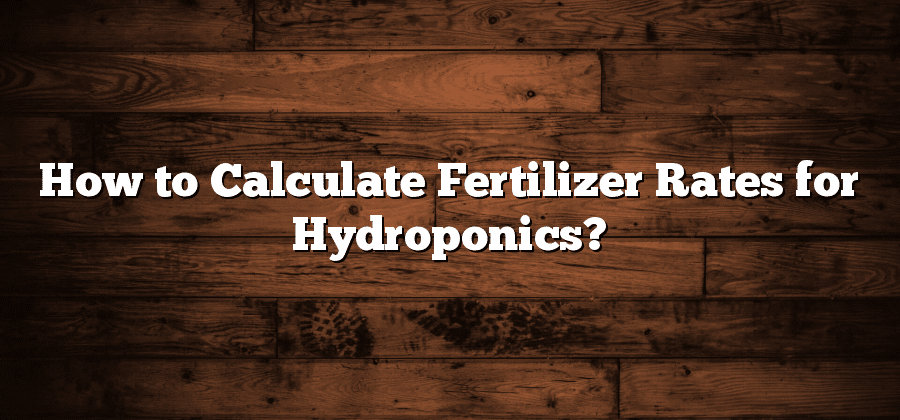Understanding the Nutrient Requirements in Hydroponics
Hydroponics is a cultivation method that has gained significant attention in recent years, thanks to its ability to grow plants without soil. Instead, plants are grown in a nutrient-rich solution that provides all the necessary elements for their growth and development. Understanding the nutrient requirements in hydroponics is essential for ensuring optimal plant health and productivity.
In hydroponics, plants obtain nutrients from the nutrient solution, which serves as their primary source of sustenance. This solution must contain all the essential elements that plants need for their growth, such as nitrogen, phosphorus, potassium, calcium, magnesium, and various micronutrients. The concentrations of these nutrients need to be carefully balanced to meet the specific needs of different plant species and growth stages. Achieving this balance requires a comprehensive understanding of the nutrient requirements of the plants being cultivated, along with regular monitoring and adjustments to the nutrient solution. By providing plants with the optimal nutrient levels, hydroponic growers can maximize the productivity and quality of their crops, leading to more sustainable and efficient cultivation practices.
Evaluating the Water Quality for Hydroponic Systems
Water quality is a crucial factor to consider in hydroponic systems as it directly affects the overall health and productivity of the plants. Evaluating the water quality involves analyzing several key parameters including pH level, electrical conductivity (EC), total dissolved solids (TDS), and the presence of any harmful contaminants.
Maintaining the appropriate pH level is essential for ensuring nutrient availability to plants. Ideally, the pH should be within the range of 5.5 to 6.5. Anything above or below this range can lead to nutrient deficiencies or toxicities, negatively impacting plant growth. Additionally, high EC and TDS levels can indicate an excessive concentration of dissolved salts in the water, which can hinder nutrient uptake. Regular monitoring and adjusting of these parameters are necessary to maintain the desired water quality in hydroponic systems.
Selecting the Right Fertilizer for Hydroponics
Hydroponic systems provide a controlled environment for growing plants without the use of soil. In these systems, plants derive all their nutrients from a nutrient solution that is delivered directly to their roots. Selecting the right fertilizer for hydroponics is crucial to ensure optimal plant growth and maximize yields.
When it comes to choosing a fertilizer for hydroponics, several factors need to be considered. Firstly, it is important to look for a fertilizer that is specifically formulated for hydroponic use. These fertilizers are designed to provide the essential nutrients that plants need in the right proportions and concentrations. Additionally, consider the nutrient content of the fertilizer. It should contain a balanced ratio of macronutrients such as nitrogen, phosphorus, and potassium, as well as essential micronutrients like iron, zinc, and manganese. The availability of these nutrients is vital for promoting healthy plant growth and preventing nutrient deficiencies. Furthermore, it is advisable to select a fertilizer that is water-soluble. This allows the nutrients to easily dissolve in the hydroponic system’s water, ensuring that the plants can absorb them effectively.
Determining the Ideal Nutrient Solution Concentration
Determining the ideal nutrient solution concentration is crucial for the success of any hydroponic system. This concentration refers to the ratio of nutrients to water in the nutrient solution. It plays a vital role in providing the necessary elements for the plants’ growth and development.
To determine the ideal nutrient solution concentration, several factors need to be considered. Firstly, the type of crop being grown is a significant determinant. Different plants have varying nutrient requirements, and it is essential to tailor the concentration accordingly. Additionally, the growth stage of the plants should be taken into account. Younger plants require a lower concentration initially, while more mature plants may need a higher concentration to support their continued growth. Lastly, the specific hydroponic system being used can also influence the ideal concentration. Factors such as the nutrient delivery method and the size of the reservoir can affect the nutrient uptake by the plants.
Calculating the Nutrient Solution Volume for Hydroponics
When it comes to growing plants hydroponically, it is crucial to provide them with the right amount of nutrients in the nutrient solution. One important aspect in determining the nutrient solution volume is the size of the plant root zone. The root zone is the area where the plants’ roots grow and absorb water and nutrients. The volume of the nutrient solution should be sufficient to cover the entire root zone, ensuring that the plants have access to the necessary nutrients.
To calculate the nutrient solution volume for hydroponics, you will need to consider the size and type of the hydroponic system, as well as the number and size of the plants you are growing. One common method is to measure the depth and width of the plant containers or growing beds. Multiply these measurements by the number of plants in the system to determine the total volume needed. It is important to note that the nutrient solution volume should be replenished regularly to maintain the optimal nutrient concentration for the plants. By carefully calculating the nutrient solution volume, you can ensure that your hydroponic plants receive the necessary nutrients for healthy growth.






